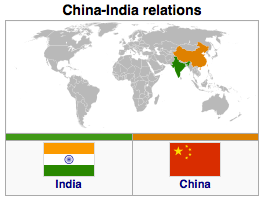China – India: Reopening The Demchuk-Mansarovar Route: Exploring Possibilities – Analysis
By IPCS
By Zainab Akhter
There are two routes in Ladakh, which connect India to China: the Karakoram pass in the Nubra Valley and the second through Leh-Demchuk to Kailash Mansarovar. The Leh-Damchuk route runs through the Demchuk village in Leh and further connects India to western Tibet in China, where the Line of Actual Control (LAC) between the two countries lies. This route has historical significance as it was used to facilitate trade between India and China.
Domestic Pressure

For a long time there has been a demand from the Indian side to reopen the Leh-Demchuk route to western Tibet. This route is seen as a potential route towards the economic development of both India and China.It is expected to serve the same purpose as the Nathu La Pass, which connects Sikkim with Tibet and was thrown open for trade in 2006 following numerous bilateral trade agreements. Every year the Indian government organises the Kailash-Manasarovar Yatra to Mansarovar Lake, which lies in western Tibet. Manasarovar Lake has religious significance as it is a place of pilgrimage and attracts devotees from India, Nepal, Tibet and the neighbouring countries.
At present, it takes 27 days to complete the yatra, trekking through rocks via Uttaranchal which is prone to landslides and other risks. Opening of the Demchuk-Mansarovar route will drastically reduce the journey time of the pilgrims to two hours by road transportation. On the other hand, if one decides to trek to the Mansoravar Lake along the Sindu River, it will take only four days for the completion of the yatra. The Demchuk-Mansarovar route will be the shortest and safest way to access the Mansoravar Lake, and it will also be more economical for the pilgrims, which will consequently increase the number of visitors.
Security Concerns
Chinese incursions, ingressions and violation of airspace in the Demchuk sector have reported for a couple of years. The development work on the Chinese side is taking place rapidly and the Chinese have built an airport and a metalled road to their border villages, while on the Indian side in Demchuk there is no mobile connectivity or electricity, and the roads are in a poor condition. The Indian side suspects China of using these infrastructures for a dual purpose -both civil and military.
With the building of Chinese forces along the border, India has increased its vigil as a pre-emptive measure. The opening of the Demchuk-Mansarovar route will open this border village to the outside world, which will lead to infrastructure development on the Indian side. This will help India to keep a check on the activities on the Chinese side. It is hoped that theintrusions and hovering across the LAC by the Chinese will decrease to a great extent.
The Ladakh Hill Development Council (LHDC) is hopeful of reopening the Leh-Kailash Mansarovar route. The “Ladakh 2025 Vision Document”, which is a road map of the developmental projects to be carried out by the LHDC, also talks about the opening of the Leh-Demchuk-Mansoravar route and how it can bring developmental changes in the border areas of Ladakh.
The Chinese are reluctant to the idea of reopening the route. The reopening of the route can interfere in the incursion activities and it will expose the true nature of the developmental work they are carrying out in the area.
Economic boost to the region
Demchok is a small village and military encampment in the Leh district of Ladakh .The Leh-Demchuk-Mansarovar route would further open the frontier regions of Ladakh to tourism. More infrastructure and shops will come up on both sides of the border, thereby increasing the employment opportunities for these otherwise inaccessible villagers.
Besides, the Demchuk village is famous for its hot water spring, and the hydro-therapy centre has become a major attraction for people from other parts of Ladakh, who throng the place in large numbers to take a dip in the spring. The pilgrims can also explore the hot springs in Ladakh, which will make it a major tourist spot in the region.
The future course
The people of Ladakh are insisting on the reopening of this route for years due to the economic benefits that such a move would bring to the region.
The Leh-Demchuk-Mansoravar route will be operational only when the governments of both the countries come to a concurrence. The Government of Jammu and Kashmir has convinced the Union Government of India about the potentialities of reopening the route. However, the Chinese government has not yet responded to the proposal for the reopening of this route. India needs to diplomatically negotiate with the Chinese government in order to implement this proposal.
The problem of connectivity between India and China can only be solved through a cooperative and inclusive approach as against a competitive and exclusive one. Geoeconomics and geoculture must take priority over competitive geopolitics to address the problem of connectivity between the two important Asian countries.
Zainab Akhter
Research Intern, IPCS
email: [email protected]

I am From Ladakh but i strongly condemn the Statement that “due to Economic Benifits we demanded the India-China route to Open”.
It is actually the Indo-Tibet route that we always requested to be flourished by asking our Indian Govt to stand with Tibet and its Freedom from China.
With the Chinese Infiltration witnessed by my ownself and many of my Ladakhi Counterparts, I dont think we will ever be on a sedge to trade with a national humanism purpose for selfish demands.